内蒙古草原土壤有机物提取分离及鉴定*
2017-12-11刘盛兰刘洪林阿拉木斯李加荣赵章涛吴洪新
刘盛兰 刘洪林 阿拉木斯† 李加荣†赵章涛 张 奇 吴洪新 王 海 纪 磊 秦 艳
(1 北京理工大学化学与化工学院,北京 102488)
(2 中国农业科学院草原研究所,呼和浩特 010018)
内蒙古草原土壤有机物提取分离及鉴定*
刘盛兰1刘洪林2阿拉木斯2†李加荣1†赵章涛1张 奇1吴洪新2王 海2纪 磊2秦 艳2
(1 北京理工大学化学与化工学院,北京 102488)
(2 中国农业科学院草原研究所,呼和浩特 010018)
土壤中的有机物对于斥水性的研究具有重要的作用,但是目前关于内蒙古草原土壤的研究主要集中在有机碳上,而对土壤中有机物种类的研究很少。选取内蒙古锡林浩特市南部的牧草土壤样品,使用溶剂超声萃取的方法,对土壤中的有机物进行了分析。结果发现,石油醚的粗提物最少,异丙醇/氨水(7∶3)的粗提物最多。粗提物经紫外、红外和GC-MS测定,结果表明用石油醚、异丙醇和甲醇作为萃取剂,得到的有机物主要为直链或环烃化合物,含量占总提取物的95%以上;氯仿及异丙醇/乙酸(7∶3)和异丙醇/氨水(7∶3)提取物除了含有直链或环烃化合物外,还含有酯、酰胺和甾类化合物,且甾类化合物在异丙醇/氨水提取物中含量相对最高。采用异丙醇/氨水对所有土壤样品进行萃取,发现NM1和NM7提取物中甾类化合物的含量较高,占总提取物的25%左右。异丙醇/氨水的粗取物用石油醚:乙酸乙酯(4∶1)作洗脱剂,经柱层析分离主要得到A、B两部分;经GC-MS测定、质谱图库检索表明A为甾酮类物质,B为不含氧的甾烯类或者甾醇类物质。
土壤有机物;超声提取;GC-MS;柱色谱;甾类化合物
内蒙古草原属于半干旱气候区,不仅是我国肉、奶的重要产地之一,也是我国北部地区极为重要的生态屏障[1]。近几十年来,由于不合理利用和持续干旱导致草原土壤严重退化,土壤接纳和保蓄降水的能力降低,斥水性严重。研究表明,造成土壤斥水性的主要原因是土壤中的有机物(烷烃、脂肪酸/酯、植烷醇、植烷和固醇、酰胺、醛/酮和复杂的环状化合物)[2-7],其主要来源于植物根茎叶及其分泌物、真菌和其他微生物的代谢产物、以及土壤污染等[8-11]。目前研究发现土壤中的有机物主要包括直链烷烃、酸类、醇类、石蜡、萜类、甾类、蜡、单酮、β-二酮和酯类化合物等[12-13],且地区不同、土层深度不同所含有机物的种类和含量均有差别[14-18]。国内有关土壤有机物的研究主要集中在土壤总有机碳分布[19-21]、土壤中有机污染物的提取鉴定[22-23]以及土壤中有机物类型的研究[24-25],而少有对土壤中有机物进行全面地分离鉴定。为此,为确切知道内蒙古草原土壤有机物的分布、种类及含量,以便于构建某种有机物与斥水性的关联,本文选取内蒙古草原典型土壤样品,采用溶剂超声萃取、柱层析分离,GC-MS鉴定首次明确了内蒙古草原土壤有机物的种类和含量,为进一步研究土壤有机物与斥水性的关系提供基础。
1 材料与方法
1.1 研究区概况
研究区位于内蒙古锡林浩特市南部草原地区,地理坐标为43°33′~43°55′ N,116°06′~116°43′ E,海拔1 061~1 250 m,气候属中温带半干旱大陆性气候。研究区年平均气温0.57 ℃,年均降水量350.4 mm,平均日照时数为2 617.5 h。风活动频繁,全年大风天数达71 d,4—6月最为频繁,一般占全年大风天数1/2左右。
1.2 供试材料
供试土壤为栗钙土。2015年6月于研究区每间隔一定距离设定一个采样点,共采集土壤样品7个,依次编号为NM1、NM2、NM3、NM4、NM5、NM6、NM7,采样深度为0~5 cm。土壤样点基本情况见表1。所采集样品室内风干,剔除根系、砾石等杂质后过2 mm筛备用。

表1 土壤样点的基本情况Table 1 Base information of the soil sample
试验所用试剂为分析纯。
1.3 土壤有机物的提取
分别采用石油醚(60~90 ℃)、氯仿、异丙醇、甲醇、异丙醇/乙酸(5.2 mol L-1)(7∶3)、异丙醇/氨水(14.8 mol L-1)(7∶3)对NM4土壤样品进行提取,提取物依次编号为NM4-1、NM4-2、NM4-3、NM4-4、NM4-5、NM4-6。方法参照文献[26,3],具体步骤如下:称取500.00 g土壤样品于1 L烧杯中,分别加入500 ml提取剂,用塑料膜封口,浸泡过夜后超声提取30 min(KQ5200B超声波器,超声频率:40 kHz,超声功率:200 W),抽滤,将滤液在旋转蒸发仪上减压除去溶剂(40~55 ℃),并将提取物真空干燥,称量不同溶剂提取物的质量。
将异丙醇/氨水和异丙醇/乙酸提取物再次溶于200 ml氯仿/水(1∶1)溶液中进行萃取[7],静置后溶液分为两层,上层为水相,主要含有两亲化合物和极性化合物,下层为氯仿相,主要含脂类化合物[4]。将氯仿相减压浓缩至干(40 ℃),称量氯仿相化合物的质量。
采用异丙醇/氨水分别对NM1~NM7这7种土壤样品一一进行超声提取,提取物编号依次为NM1-6、NM2-6、NM3-6、NM4-6、NM5-6、NM6-6、NM7-6。具体操作为:称取不同土壤样品500.00 g于1 L烧杯中,加入500 ml 异丙醇/氨水(14.8 mol L-1)(7∶3),用塑料膜封口,浸泡过夜后超声提取30 min,抽滤,将滤液在旋转蒸发仪上减压除去溶剂(55 ℃)。提取物用200 ml氯仿/水(1∶1)溶液进行萃取,将氯仿相减压浓缩至干(40 ℃),称量氯仿相化合物的质量。
1.4 土壤提取物的鉴定
土壤提取物的鉴定主要采用紫外光谱(UV)、红外光谱(IR)、GC-MS等进行。
紫外可见光光谱测定,从每个提取液中取出少量液体,用TU-1901紫外分光光度计(北京普析通用仪器有限责任公司)测定,扫描范围为200~800 nm,来观察提取物的吸收情况。为避免浓度的差异对特定波长吸收值的影响,单位浓度单位浓度吸光值为将所测样品的浓度稀释至1 mg L-1后测定的值。
红外光谱的测定,使用美国Pcrkin-Elimer公司XT4A傅立叶红外光谱仪,实验中采用KBr压片。用毛细管蘸取少量提取物于离心管中,然后加入适量丙酮(分析纯)溶解,把样品均匀地涂抹在KBr薄片上,并用该丙酮溶液为背景,扫描波长为450~4 000 cm-1。
GC-MS的测定采用Thermo Fisher-DSQ气质联用仪,溶剂为氯仿(色谱纯),进样量1 µl,不分流进样。色谱条件:色谱柱为AB-5MS(30 m×0.25 mm×0.25 µm)弹性石英毛细管柱,柱温80 ℃持续2 min,以10 ℃ min-1的升温速率升温至300 ℃,保持15 min;进样口温度250 ℃;载气为He,载气流量1.0 ml min-1。质谱条件:离子源为EI源;离子源温度250 ℃;电子能量70 eV;扫描模式全扫描;扫描范围(m/z)35.0~650.0 amu。GC-MS数据应用标准质谱谱库NIST02获得,采用面积归一化法计算各组分的相对含量。
1.5 土壤有机物的分离
首先选用石油醚、氯仿、乙酸乙酯及甲醇及其混合溶剂对异丙醇/氨水的提取物进行展开,图1a为石油醚、氯仿和乙酸乙酯的展开结果,未能展开;图1b为甲醇的展开结果,所有的样品全爬至薄层顶端。改用乙酸乙酯:石油醚(1∶4)混合展开剂(图1c),254 nm处有一非常明显的点(c1:A,Rf=0.56);当用糖显色时发现还有一点(c2:B,Rf=0.21)。研究选用该展开剂对粗提物进行柱层析,以期得到点A、B提取物。(层析板型号:HSGF254;涂层厚度:0.2 mm±0.03 mm;硅胶粉粒度:10~40 µm)
确定展开剂后进行柱层析实验分离土壤有机物。采用湿法装柱,硅胶填充,柱尺寸为26 mm ×203 mm;干法装样,乙酸乙酯:石油醚(1∶4)洗脱,Rf值相同的试样浓缩,浓缩物用于GC-MS分析。
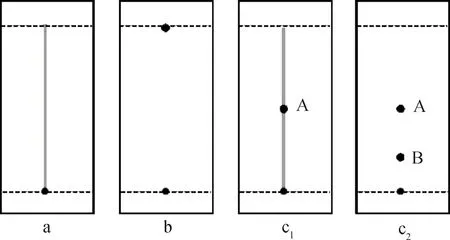
图1 不同展开剂薄层板展开情况Fig. 1 Development on thin layer plates using different developing agents
1.6 数据处理
数据采用Origin 9.0软件进行分析处理及图谱叠加。
2 结果与讨论
2.1 不同提取剂对土壤有机物提取的影响
石油醚、氯仿、异丙醇、甲醇、异丙醇/乙酸和异丙醇/氨水6种提取剂对NM4土壤样品的提取情况见表2。
由表可知,使用不同提取剂,粗提物的外观和质量均有差异。异丙醇/氨水的氯仿提取物最多,达0.61 g,而石油醚、氯仿、异丙醇和甲醇提取物相对较少。不同溶剂的提取物的外观也不相同,石油醚、氯仿、异丙醇提取物为黄色;而异丙醇/乙酸、异丙醇/氨水的提取物为深褐色。
各提取物的紫外光谱见图2。由图2可知,所有提取物的紫外-可见光吸收波长均集中在200~480 nm范围内,且石油醚、氯仿、异丙醇/乙酸和异丙醇/氨水的提取物在230 nm左右吸光度开始急剧上升,至240 nm左右达到最高吸收峰值,然后开始下降。异丙醇/乙酸和异丙醇/氨水提取物在390 nm左右存在一吸收平台。甲醇和异丙醇提取物在200 nm处急剧上升到达最高吸收峰值209 nm,然后开始下降。所有提取物的吸收值随着波长减小呈上升趋势,并在260 nm或280 nm附近有一吸收平台,这与腐殖酸的紫外光谱的基本特征类似[27],表明所有提取物中可能均含有腐殖酸。

表2 不同溶剂提取NM4样品得到的化合物Table 2 Compounds extracted from NM4 samples using different solvents

图2 NM4样品不同溶剂提取物的紫外光谱Fig. 2 UV spectra of the extracts of NM4 relative to solvent
各提取物的红外光谱见图3,由图3可知,石油醚、氯仿、异丙醇、甲醇和异丙醇/乙酸及异丙醇/氨水的光谱基本相似,主要的峰分别为2 960 cm-1(CH3)、2 920 cm-1(CH2)、2 850 cm-1(CH2)、1 732 cm-1(C=O)、1 460 cm-1(CH2)和1 375 cm-1(C-CH3)[28];甲醇和异丙醇/氨水及异丙醇/乙酸提取物在1 667 cm-1附近还有一个吸收强度稍弱的吸收峰,可能为芳环骨架或酰胺缔合C=O双键。
NM4提取物的GC-MS总离子流色谱图见图4。由图4可知,不同提取物的GC-MS的峰基本一致,主要集中在保留时间为17~30 min内[7],NM4-1石油醚提取物在保留时间27 min后基本没有峰,可能是因为石油醚的极性较小,所提物质较少所致。
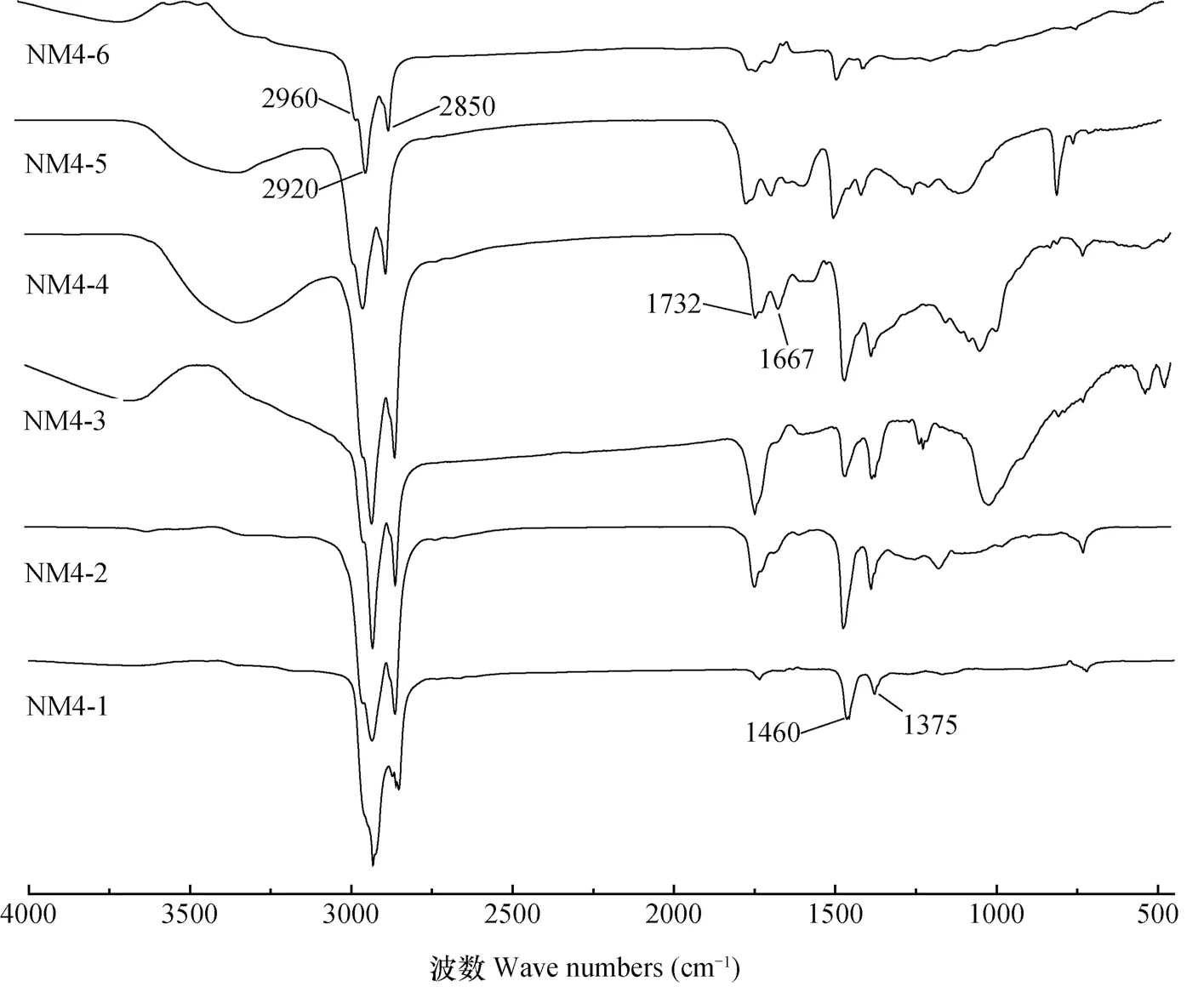
图3 NM4样品不同溶剂提取物的红外光谱Fig. 3 IR spectra of the extracts of NM4 relative to solvent
用NIST02标准质谱库对NM4提取物的GC-MS进行检出,相应峰值可能对应的检出物及其含量见表3。结果表明石油醚、异丙醇和甲醇的提取物主要为直链或环烃类化合物;两种醇的提取物所含化合物基本相同,但甲醇提取物中还鉴定到芥酸酰胺;氯仿及异丙醇/氨水和异丙醇/乙酸三者的提取物中除了含有直链或环烃化合物外还包括酯类、酰胺类和甾类化合物,其中异丙醇/氨水和异丙醇/乙酸的提取物中还含有酚、脂肪酸等化合物。
由提取物的相对含量可以看出:石油醚、异丙醇和甲醇提取物中烃类含量占总提取物的95%以上,氯仿提取物中烃类含量占总提取物的90%左右,而异丙醇/氨水和异丙醇/乙酸提取物中烃化物仅占总提取物的70%左右。烃化合物是这6种提取物中含量最多的化合物,且碳原子数为20~31的长直链脂肪烃化合物,而且C23的直链烃含量最高。甾类化合物(主要为谷甾醇)仅从氯仿、异丙醇/氨水和异丙醇/乙酸作为溶剂时提取到的化合物中检测到,相对含量均不高,其中异丙醇/氨水提取到的甾体类化合物含量相对最高[4]。
2.2 不同采样地点对土壤有机物提取的影响
采用前述提取NM4-6样品的工艺,对其他样品进行处理,粗提物的外观和重量见表4。由表4可知,不同地点的异丙醇/氨水提取物有一定差别,NM5和NM6样品的提取物重量最少,其他地点的样品提取物重量差不多,NM3提取物重量最高。
紫外光谱结果显示,异丙醇/氨水对不同地点的提取物在200~480 nm范围内均有吸收,在波长230 nm左右吸光度开始急剧上升,至240 nm左右达到最高吸收峰值,而后开始下降,情况与图2相似。
红外光谱中,异丙醇/氨水对不同样品提取物的红外特征吸收峰基本一致,且与图3相似,不同的是1 215 cm-1、1 170 cm-1和1 042 cm-1附近有较弱的吸收峰,可能来自酯键或醇的C-O-C扰动吸收;且在3 300 cm-1附近有一吸收峰,可能是氨基或者羟基的吸收峰。
异丙醇/氨水对不同样品的提取物对应的可能化合物及含量见表5。通过GC-MS对这七个样品的初步鉴定结果显示,七个采样地点所含化合物基本相同,大致有30个,主要是酚、酯、烃、酸、酰胺、甾等六种化合物,这与文献中报道的土壤提取物所含有的种类基本一致[12-13]。
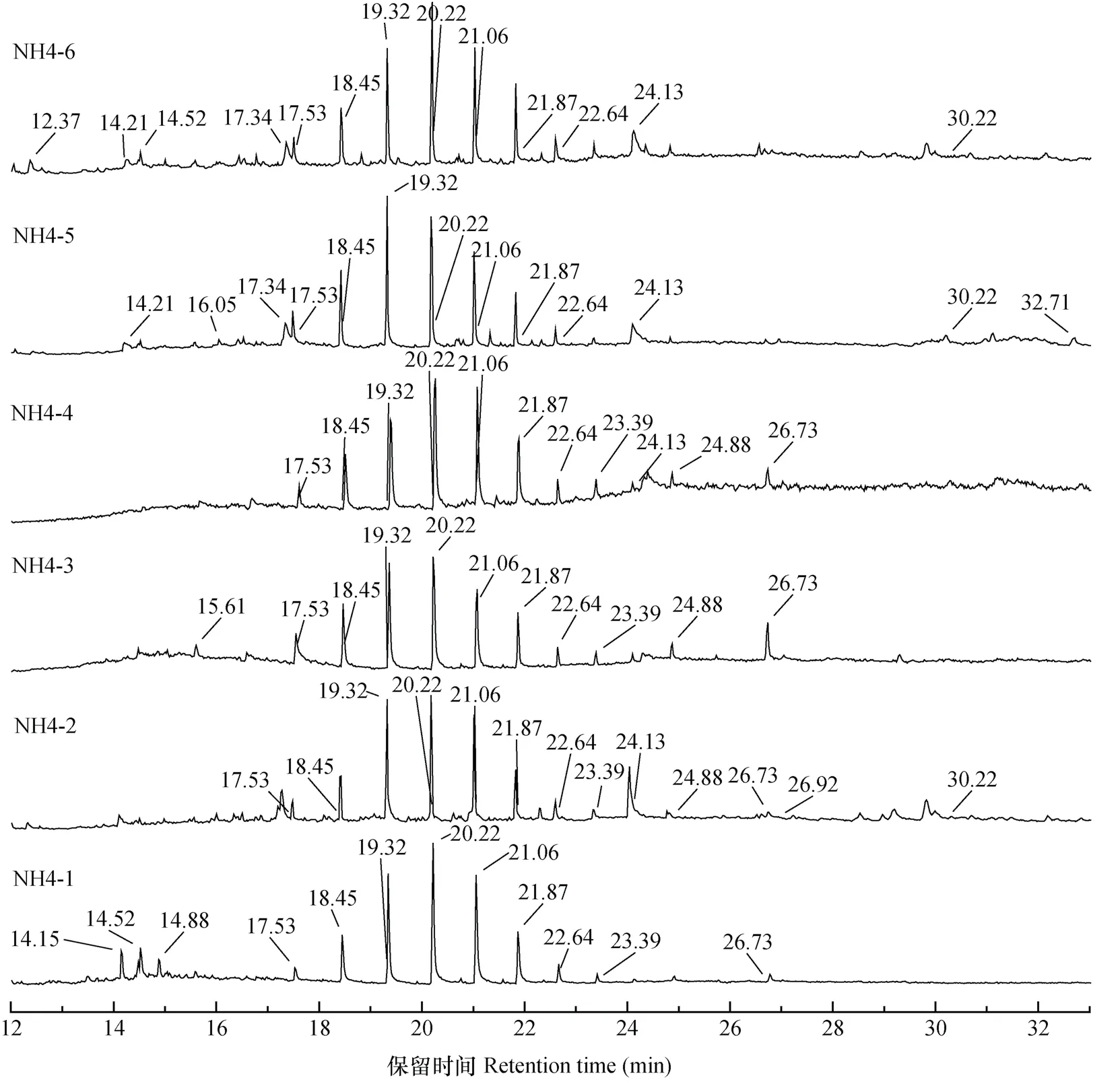
图4 NM4样品不同溶剂提取物的总离子流色谱Fig. 4 Total ions chromatogram of the extracts of NM4 relative to solvent
在检测到的有机化合物中烃类物质占有很大比重,主要是一些长直链烃类化合物,碳链长度集中在C20~C27之间,其中NM1、NM2和NM7样品中含直链烃的比例在30%左右,其他样品中直链烃类高达60%左右;除了NM1和NM6样品中C22的烃类最多外,其余样品中C23的烃最多。此外,还有一些带有支链的长链烃和一些烯烃,但含量相对较少。
酚类化合物主要在前五个样品中检测到,且含量相对较少,仅占检测到的化合物的1%~4%;前六个样品所含棕榈酸及其酰胺等长直链酸或酰胺的含量在10%~17%之间[4],而NM7所含该类物质的含量高达34%左右;样品检测所含柠檬酸三乙酯及邻苯二甲酸二丁酯等酯的含量占到总检有机物的15%~25%之间。Morley等[7]从土壤提取物中鉴定出了甾类化合物,包括一些甾醇类及甾酮类化合物。在样品NM1和NM7中该类物质含量在25%~29%之间,而其余样品含量相对较少在2%~13%之间,尤其是γ-谷甾醇[29],其在各个样品中均有鉴别到并且其相对含量均在2%以上,NM1-6及NM7-6样品中的该提取物达到15%左右。
2.3 GC-MS对柱色谱分离后得到的化合物鉴定结果
异丙醇/氨水所有提取物经过柱色谱分离纯化后,分别收集到在薄层板上显示Rf为0.56和0.21(A、B)两部分物质,其总离子流色谱见图5。A部分的化合物主要出峰时间集中在30~34 min之间,而B部分的化合物主要集中在25~30 min之间。对它们分别进行GC-MS分析,A部分的GC-MS总离子流色谱图出峰比较明显,分离效果较好,有四个相对较大的峰,由质谱图库检索每个峰所对应的化合物主要为甾酮类物质(表6),占总量的80%左右。B部分的GC-MS总离子流色谱图峰型相对比较复杂,峰比较多,化合物没有完全分离开,由质谱图库检索每个峰所对应的可能化合物为甾烯类或者甾醇类物质(表6),其中甾醇的含量较高,占总量的85%以上,甾烯的含量较少,只占7%左右。

表3 NM4提取物及其相对含量Table 3 Extracts of NM4 and their relative contents

表4 异丙醇/氨水对不同样品提取物的情况Table 4 Extracts from different samples using isopropanol/ammonia
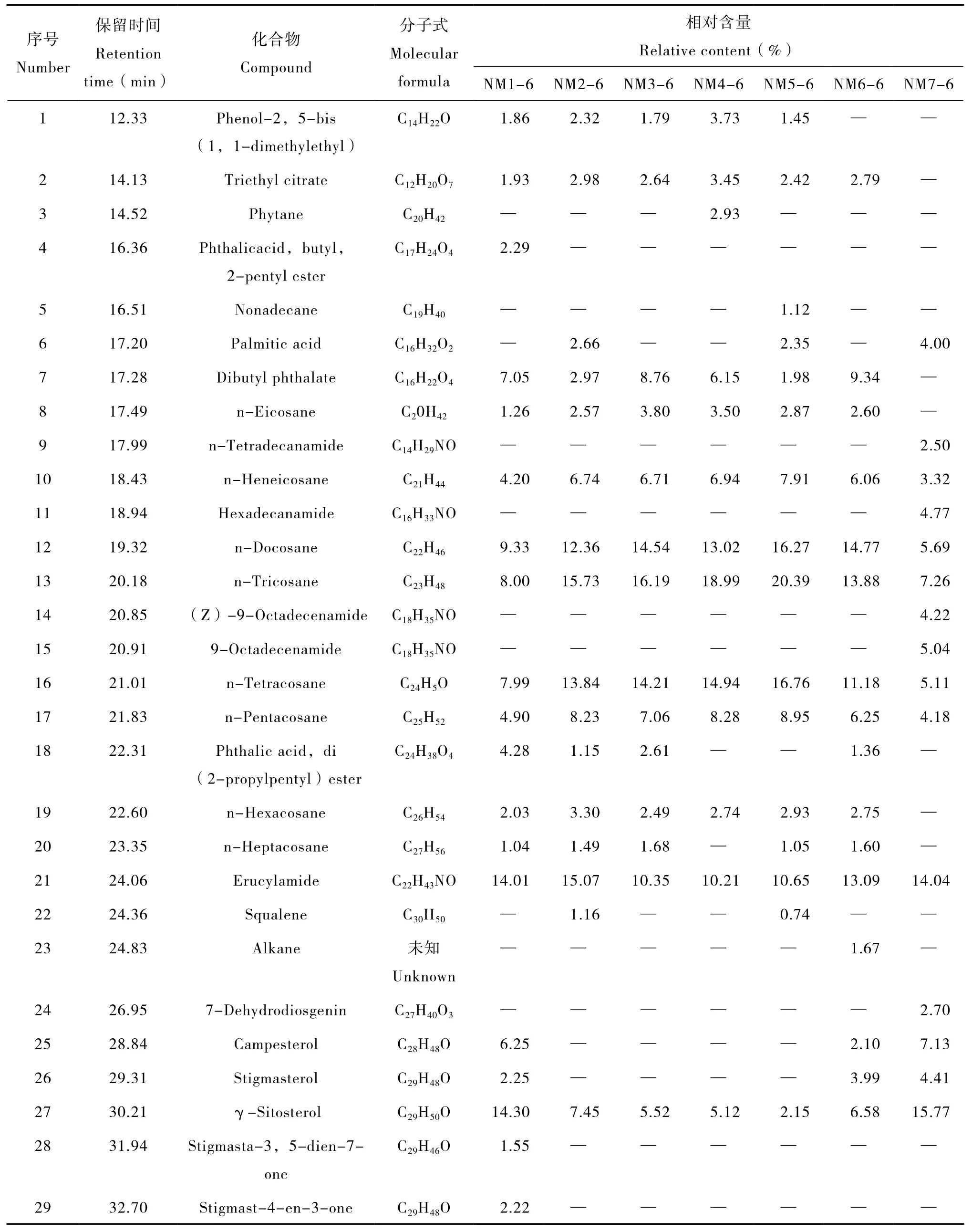
表5 不同地点样品用异丙醇/氨水提取得到的主要化合物Table 5 Main compounds extracted from different samples with isopropanol/ammonia
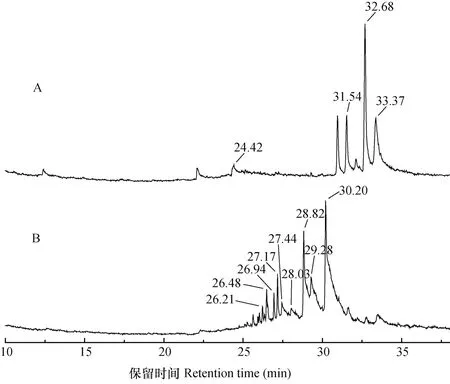
图5 柱色谱分离的A、B部分的总离子流色谱Fig. 5 Total ions chromatogram of A and B after column chromatography

表6 A和B部分通过GC-MS鉴定所得化合物表Table 6 Compounds identified with GC-MS in A and B
3 结 论
先经溶剂超声萃取,再用柱色谱进行分离,对典型内蒙古草原牧草土壤有机物分离提取发现使用石油醚、异丙醇和甲醇等单溶剂超声萃取所得萃取物主要为直链或环烃类化合物;而氯仿及异丙醇/乙酸和异丙醇/氨水的超声萃取物除了含有直链或环烃化合物外,还包括酯类、酰胺类和甾类化合物。以石油醚:乙酸乙酯(4∶1)为展开剂,对异丙醇/氨水的萃取物进行柱色谱分离,可以得到两部分化合物(A和B);经GC-MS测定,前者主要含有四种化合物,其中甾酮物占到80%左右;后者所含有化合物较多,主要为甾烯和甾醇化合物,占到总量的90%左右。
[1] 朝博,乌云,乌恩. 气候变化背景下内蒙古草原水资源保护与可持续利用. 中国草地学报,2012,34(5):99—106 Chao B,Wu Y,Wu E. Protection and sustainable utilization of water resources in Inner Mongolia grassland under the background of climate change(In Chinese). Chinese Journal of Grassland,2012,34(5):99—106
[2] Ma’Shum M,Tate M E,Jones G P,et al. Extraction and characterization of water-repellent materials from Australian soils. Journal of Soil Science,1988,39(1):99—110
[3] Roy J L,Mcgill W B,Rawluk M D. Petroleum residues as water-repellent substances in weathered nonwettable oil-contaminated soils. Canadian Journal of Soil Science,1999,79(2):367—380
[4] Horne D J,Mcintosh J C. Hydrophobic compounds in sands in New Zealand—Extraction,characterisation and proposed mechanisms for repellency expression.Journal of Hydrology,2000,231/232(10):35—46
[5] Franco C M M,Clarke P J,Tate M E,et al. Studies on non-wetting sands. II. Hydrophobic properties and chemical characterisation of natural water repellent materials. Journal of Hydrology,2000,231/232(10):47—58
[6] Graber E R,Tagger S,Wallach R. Role of divalent fatty acid salts in soil water repellency. Soil Science Society of America Journal,2009,73(2):541—549
[7] Morley C P,Mainwaring K A,Doerr S H,et al.Organic compounds at different depths in a sandy soil and their role in water repellency. Australian Journal of Soil Research,2005,43(3):239—249
[8] Ritsema C J,Dekker L W. Water repellency and its role in forming preferred flow paths in soils. Australian Journal of Soil Research,1996,34(4):475—487
[9] Hallett P D,Baumgartl T,Young I M. Subcritical water repellency of aggregates from a range of soil management practices. Soil Science Society of America Journal,2001,65(1):184—190
[10] Mcghie D A,Posner A M. The effect of plant top material on the water repellence of fired sands and water repellent soils. Australian Journal of Agricultural Research,1981,32(4):609—620
[11] Hallett P D,White N A,Ritz K. Impact of basidiomycete fungi on the wettability of soil contaminated with a hydrophobic polycyclic aromatic hydrocarbon. Biologia,2006,61(19 Suppl):S334—S338
[12] Kaneda T. Iso-and anteiso-fatty acids in bacteria:Biosynthesis,function,and taxonomic significance.Microbiological Reviews,1991,55(2):288—302
[13] Naafs D F W,Bergen P F V,Boogert S J,et al.Solvent-extractable lipids in an acid andic forest soil;variations with depth and season. Soil Biology amp;Biochemistry,2004,36(2):297—308
[14] Atanassova I,Doerr S. Organic compounds of different extractability in total solvent extracts from soils of contrasting water repellency. European Journal of Soil Science,2010,61(2):298—313
[15] Blas E D,Almendros G,Sanz J. Molecular characterization of lipid fractions from extremely waterrepellent pine and eucalyptus forest soils. Geoderma,2013,206(9):75—84
[16] Steinmetz Z,Kurtz M P,Dag A,et al. The seasonal influence of olive mill wastewater applications on an orchard soil under semi-arid conditions. Journal of Plant Nutrition amp; Soil Science,2015,178(4):641—648
[17] Jaramillo D F,Dekker L W,Ritsema C J,et al.Occurrence of soil water repellency in arid and humid climates. Journal of Hydrology,2000,231/232(10):105—111
[18] Doerr S H,Shakesby R A,Walsh R P D. Soil water repellency:Its causes,characteristics and hydrogeomorphological significance. Earth-Science Reviews,2000,51(1/4):33—65
[19] 刘伟,程积民,高阳,等. 高原草地土壤有机碳分布及其影响因素. 土壤学报,2012,49(1):68—76 Liu W,Cheng J M,Gao Y,et al. Distribution of soil organic carbon in grassland on Loess Plateau and its influencing factors(In Chinese). Acta Pedologica Sinica,2012,49(1):68—76
[20] 戴尔阜,翟瑞雪,葛全胜,等. 1980s-2010s内蒙古草地表层土壤有机碳储量及其变化. 地理学报,2014,69(6):1651—1660 Dai E F,Zhai R X,Ge Q S,et al. Topsoil organic carbon storage and its changes in Inner Mongolia grassland from the 1980s to 2010s(In Chinese). Acta Geographica Sinica,2014,69(6):1651—1660
[21] 杨勇,宋向阳,咏梅,等. 不同干扰方式对内蒙古典型草原土壤有机碳和全氮的影响. 生态环境学报,2015,24(2):204—210 Yang Y,Song X Y,Yong M,et al. Impacts of different disturbances on soil organic carbon and total nitrogen of typical steppe in Inner Mongolia(In Chinese). Ecology and Environmental Sciences,2015,24(2):204—210
[22] 胡祖国,曹攽,李紫艺. 超声波萃取—气相色谱-质谱法测定土壤中7种酚类化合物. 冶金分析,2016,36(2):27—32 Hu Z G,Cao B,Li Z Y. Determination of seven phenols in soil by gas chromatography-mass spectrometry after ultrasonic extraction(In Chinese). Metallurgical Analysis,2016,36(2):27—32
[23] 刘秀芝. 微波方法提取土壤中多氯联苯和有机氯农药研究. 黑龙江环境通报,2016,40(1):29—31 Liu X Z. Study on extraction of PCBs and organochlorine pesticides in soil by microwave method(In Chinese).Heilongjiang Environmental Journal,2016,40(1):29—31
[24] 窦森,Lichtfouse E,Mariotti A. 土壤胡敏酸的水解和分组方法. 土壤通报,1998,29(5):206—208 Dou S,Lichtfouse E,Mariotti A. Hydrolysis and compounds of humic acids(In Chinese). Chinese Journal of Soil Science,1998,29(5):206—208
[25] 窦森,Lichtfouse E,Mariotti A. 土壤胡敏酸的温和水解及分组研究 Ⅱ. 胡敏酸水解产物中的醇类化合物. 土壤通报,2002,33(1):17—20 Dou S,Lichtfouse E,Mariotti A. Mild hydrolysis and alcohol compounds of humic acids Ⅱ. Alcohols in hydrolyzed products of humic acids(In Chinese).Chinese Journal of Soil Science,2002,33(1):17—20
[26] Mainwaring K,Hallin I L,Douglas P,et al. The role of naturally occurring organic compounds in causing soil water repellency. European Journal of Soil Science,2013,64(5):667—680
[27] 张甲珅,曹军,陶澍. 土壤水溶性有机物的紫外光谱特征及地域分异. 土壤学报,2003,40(1):118—122 Zhang J S,Cao J,Tao S. Spatial variation of UV-VIS spectroscopy of water soluble organic carbon in eastern China(In Chinese). Acta Pedologica Sinica,2003,40(1):118—122
[28] Schnitzer M,Schuppli P. Method for the sequential extraction of organic matter from soils and soil fractions.Soil Science Society of America Journal,1989,53(5):1418—1424
[29] Kumar A,Chahal K K,Kataria D. Comparison of chemical composition of root and rhizosphere soil extracts of Tagetes patula L. :GC-MS analysis. Asian Journal of Chemistry,2017,29(4):797—800
(责任编辑:卢 萍)
Isolation and Identification of Soil Organic Matter in Inner Mongolia Grassland
LIU Shenglan1LIU Honglin2A Lamusi2†LI Jiarong1†ZHAO Zhangtao1ZHANG Qi1WU Hongxin2WANG Hai2JI Lei2QIN Yan2
(1 Beijing Institute of Technology School of Chemistry and Chemical Engineering,Beijing 102488,China)
(2 Institute of Grassland Research of CAAS,Huhhot 010018,China)
【Objective】Inner Mongolia grassland is not only one of the important meat and milk production areas of China,but also an important ecological barrier in North China. In recent decades,in addition to global climate warming and continuous drought,unreasonable use of the land resources has caused severe degradation of the grassland,and reduction of the soil’s capacity of accommodating rain water. Consequently,the soil is becoming more and more water repellent. In order to find out causes of water repellency and to help to solve the problem,it is necessary to get to know exactly distribution,species and content of the soil organic matter in the grassland,and especially relationship of the organic compounds with soil water repellency,so as to facilitate monitoring and eliminating soil water repellency. The purpose of this paper is to establish a method for separation and purification of soil organic compounds in the grassland,to obtain some certain-structured organic matter,and to lay down some foundations for further studies on relationship of the organic compounds with soil water repellency.【Method】In this paper,soil samples were collected from the surface soil layer(0~5cm)of a tract of forage grassland in the south of Xilinhot city,Inner Mongolia and petroleum ether,chloroform,isopropanol,methanol,isopropanol/acetic acid(7∶3),isopropanol/ammonia(7∶3),different in polarity were used as extraction agent for ultrasonic extraction of the soil samples. Crude extracts were tentatively identified with UV,IR and GC-MS,and then processed with column chromatography to get different species of organic compounds.【Result】The following findings were obtained. The crude extract,using isopropanol/ammonia,isopropanol/acetic acid as extraction agents was quite large in quantity,while those using petroleum ether,chloroform,isopropanol and methanol as extraction agents was less. The extracts using different solvents differed in appearance,the crude extracts using petroleum ether,chloroform,and isopropanol appeared to be yellow;while those using isopropanol/acetic acid and isopropanol/ammonia,dark brown. The UV-Vis absorption wavelengths of all the crude extracts were concentrated in the range of 200~480 nm. The crude extracts,though using different extractants,were basically quite similar in infrared spectrum,but their chief absorption peak appeared separately at 2 960 cm-1,2 920 cm-1,2 850 cm-1(C-H stretching vibration),1 732 cm-1(C‖O)1 460 cm-1and 1 375 cm-1(C-H,C-C bending vibration). Besides a relatively weak absorption peak was observed in the vicinity of 1 667 cm-1,in the IR spectra of the crude extract using methanol and isopropanol/ammonia and isopropanol/acetic acid,reflecting the existence of aromatic skeleton or amide associated with a C=O double bond. Comparison between the GC-MS of the crude extracts and the standard mass spectra reveals that hydrocarbons made up about 95% of the crude extract using petroleum ether,isopropanol or methanol extract,and only about 70% of the total extract using isotropanol/ammonia or isopropanol/acetic acid extracts,and both were dominated with C23linear hydrocarbon. Steroid(mainly sitosterol)was only detected in the crude extracts using chloroform,isopropanol/ammonia and isopropanol/acetic acid. The crude extract using isopropanol/ammonia was further separated and purified with column chromatography,and then two portions of substances displaying Rf=0.56 and 0.21(A,B)(petroleum ether:ethyl acetate =4∶1),respectively,were obtained on the plate. In the GC-MS spectra,the retention time of the compound in Part A varied mainly in the range of 30~34 min,while that in Part B mainly in the range of 25~30 min.【Conclusion】The crude extract using petroleum ether,isopropanol or methanol as extractant was composed mainly of linear or cyclic hydrocarbons;and that using chloroform,isopropanol/acetic acid(7∶3)or isopropanol/ammonia(7∶3)mainly of esters,amides and steroids besides in addition to linear or cyclic hydrocarbons. The crude extract using isopropanol/ammonia(7∶3)was separated into Part A and Part B with column chromatography. Part A was identified as steroidal ketones,and Part B as oxygen-free sterenes or sterols with GC-MS and MS library search.
Soil organic matter;Ultrasonic extraction;GC-MS;Column chromatography;Steroids
S153.6
A
10.11766/trxb201704190629
* 国家自然科学基金项目(41471198)和国家重点基础研究发展计划(973计划)项目(2014CB138801)资助 Supported by the National Natural Science Foundation of China(No. 41471198)and the National Key Basic Research Program of China(No.2014CB138801)
† 通讯作者 Corresponding author,E-mail:alms721@163.com,jrli@bit.edu.cn
刘盛兰(1992—),女,湖南人,硕士研究生,主要从事土壤有机质的研究。E-mail:2120151204@bit.edu.cn
2017-04-19;
2017-06-11;优先数字出版日期(www.cnki.net):2017-07-25
